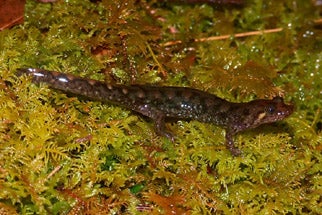SCIENTIFIC NAME:
Desmognathus monticola
STATUS:
Northern populations fairly common; southern populations uncommon to rare and may be declining. Northern distribution includes upper Appalachian Plateau Escarpment, Ridge and Valley, and Piedmont. Disjunct Coastal Plain populations known from one site in Fall Line Hills near Tennessee River, Autauga County, and several sites in Buhrstone/Lime Hills. Lowest Conservation Concern.
DESCRIPTION:
Seal salamanders are members of the family Plethodontidae, the lungless salamanders. Lungs are absent in these species and respiration is accomplished through the skin and the lining of the mouth. An average sized but stout-bodied salamander which grows to about three and one-fourth to five inches long the record length is five and seven-eights inches. The tail, comprising about half the total length of the body, is compressed and knife-edged-shaped on the top near the tip. Distinctly patterned on the top but plain and pale underneath, there is usually a distinct lateral separation in color from top to bottom. The colorations on the back vary from light brown or gray to deep black or dark brown.The color patterns are usually arranged in a net-like to circular pattern. Some are even simply patterned with dark or light spots or streaks. In Alabama, it is common to find specimens with the least amount of color patterns. Adults may lose all traces of color variation. The bottom is white in juveniles, but light gray or brown in adults. There sometimes is a row of light dots on the sides between the legs. Old adults may become purplish-brown with only a few dark markings. The young have about four pairs of round orange-brown spots down their back.
DISTRIBUTION:
Usually found in the mountainous or hilly country of the Appalachian region from Pennsylvania to Alabama. However, there is a disjunct population in the hills of southwest Alabama, and an isolated record in the extreme western panhandle of Florida. In Alabama, they range from Jackson County in the northeast corner of the state, down to Bibb County in the central portion, and over to Lee County in the east. The disjunct population is in Choctaw, Washington, Clarke, and Monroe Counties.
HABITAT:
Seal salamanders prefer cool, wet spots in well-shaded ravines and the banks of mountain streams. They usually hide under rocks or bark during the daylight hours, but sometimes can be found in shady spots in the open. At night you can find them poised at the entrance to their burrow or on top of a rock. Their appearance suggests a miniature seal. They are usually absent from larger streams where predatory fish occur.
FEEDING HABITS:
They feed on small insects, such as ants and beetles, and occasionally other salamanders.
LIFE HISTORY AND ECOLOGY:
Males often engage in combat while courting. They aggressively attack and bite other intruding males that might interfere with courtship.In mid-summer, 12 to 36 eggs are attached individually to the underside of rocks in seepages adjacent to streams. Females guard the nest.Eggs hatch by early September and the larval stage lasts for nine to ten months.
REFERENCES:
Conant, R., and Collins, J.T.1991.A Field Guide to Reptiles and Amphibians in Eastern and Central North America.Houghton Mifflin Co., Boston, MA., and New York, NY.616 pp.
Author: Chas Moore, Wildlife Biologist, Division of Wildlife and Freshwater Fisheries.






